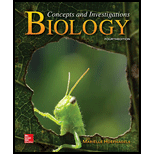
Biology: Concepts and Investigations
4th Edition
ISBN: 9780078024207
Author: Mariëlle Hoefnagels Dr.
Publisher: McGraw-Hill Education
expand_more
expand_more
format_list_bulleted
Question
Chapter 16, Problem 2MCQ
Summary Introduction
Introduction:
A virus is an infectious small particles that cannot be seen through the naked eyes. They are made up of protein coat in which their genetic material which can be either double stranded or single stranded DNA or RNA resides.
Expert Solution & Answer
Want to see the full answer?
Check out a sample textbook solution
Students have asked these similar questions
Based on your results from the Mannitol Salt Agar (MSA) media, which of your bacteria were mannitol fermenters and which were not mannitol fermenters?
help tutor please
Q8. A researcher wants to study the effectiveness of a pill intended to reduce stomach heartburn in pregnant
women. The researcher chooses randomly 400 women to participate in this experiment for 9 months of their
pregnancy period. They all need to have the same diet. The researcher designs two groups of 200 participants:
One group take the real medication intended to reduce heartburn, while the other group take placebo
medication. In this study what are:
Independent variable:
Dependent variable:
Control variable:
Experimental group: "
Control group:
If the participants do not know who is consuming the real pills and who is consuming the sugar pills.
This study is
It happens that 40% of the participants do not find the treatment helpful and drop out after 6 months.
The researcher throws out the data from subjects that drop out. What type of bias is there in this study?
If the company who makes the medication funds this research, what type of bias might exist in this
research work?
Chapter 16 Solutions
Biology: Concepts and Investigations
Ch. 16.1 - How are viruses similar to and different from...Ch. 16.1 - What determines a viruss host range?Ch. 16.1 - How do viruses evolve?Ch. 16.2 - Describe the five steps in viral replication.Ch. 16.2 - Prob. 2MCCh. 16.3 - Prob. 1MCCh. 16.3 - How is a lysogenic infection similar to and...Ch. 16.4 - Prob. 1MCCh. 16.4 - Prob. 2MCCh. 16.4 - Prob. 3MC
Ch. 16.4 - Prob. 4MCCh. 16.4 - Prob. 5MCCh. 16.4 - Prob. 6MCCh. 16.5 - Prob. 1MCCh. 16.5 - Prob. 2MCCh. 16.6 - How are viroids and prions different from viruses?Ch. 16.6 - How do viroids and prions cause disease?Ch. 16.6 - Prob. 3MCCh. 16.7 - How did researchers gather data about SIV...Ch. 16.7 - Prob. 2MCCh. 16 - Which of the following is NOT a feature associated...Ch. 16 - Prob. 2MCQCh. 16 - Prob. 3MCQCh. 16 - At which stage in viral replication does the...Ch. 16 - Although some viruses are complete after the...Ch. 16 - Prob. 6MCQCh. 16 - Which enzyme copies HTVs genetic material, forming...Ch. 16 - Prob. 8MCQCh. 16 - What is a prion? a. A highly wound circle of RNA...Ch. 16 - Prob. 1WIOCh. 16 - Your biology lab instructor gives you a petridish...Ch. 16 - Why is it inaccurate to refer to the "growth" of...Ch. 16 - Prob. 4WIOCh. 16 - Rhinoviruses replicate in the mucus-producing...Ch. 16 - Prob. 6WIOCh. 16 - Refer to figure 16.B; then explain why a mutation...Ch. 16 - Prob. 8WIOCh. 16 - Why do antibiotics kill bacteria but leave viruses...Ch. 16 - Prob. 10WIOCh. 16 - Prob. 11WIOCh. 16 - How is a biological virus similar to and different...Ch. 16 - Prob. 1PITCh. 16 - How is a virus similar to and different from a...Ch. 16 - Prob. 3PIT
Knowledge Booster
Similar questions
- What is behavioral adaptarrow_forward22. Which of the following mutant proteins is expected to have a dominant negative effect when over- expressed in normal cells? a. mutant PI3-kinase that lacks the SH2 domain but retains the kinase function b. mutant Grb2 protein that cannot bind to RTK c. mutant RTK that lacks the extracellular domain d. mutant PDK that has the PH domain but lost the kinase function e. all of the abovearrow_forwardWhat is the label ?arrow_forward
- Can you described the image? Can you explain the question as well their answer and how to get to an answer to an problem like this?arrow_forwardglg 112 mid unit assignment Identifying melting processesarrow_forwardGive only the mode of inheritance consistent with all three pedigrees and only two reasons that support this, nothing more, (it shouldn't take too long)arrow_forward
- Oarrow_forwardDescribe the principle of homeostasis.arrow_forwardExplain how the hormones of the glands listed below travel around the body to target organs and tissues : Pituitary gland Hypothalamus Thyroid Parathyroid Adrenal Pineal Pancreas(islets of langerhans) Gonads (testes and ovaries) Placentaarrow_forward
arrow_back_ios
SEE MORE QUESTIONS
arrow_forward_ios
Recommended textbooks for you
 Medical Terminology for Health Professions, Spira...Health & NutritionISBN:9781305634350Author:Ann Ehrlich, Carol L. Schroeder, Laura Ehrlich, Katrina A. SchroederPublisher:Cengage LearningEssentials Health Info Management Principles/Prac...Health & NutritionISBN:9780357191651Author:BowiePublisher:Cengage
Medical Terminology for Health Professions, Spira...Health & NutritionISBN:9781305634350Author:Ann Ehrlich, Carol L. Schroeder, Laura Ehrlich, Katrina A. SchroederPublisher:Cengage LearningEssentials Health Info Management Principles/Prac...Health & NutritionISBN:9780357191651Author:BowiePublisher:Cengage Comprehensive Medical Assisting: Administrative a...NursingISBN:9781305964792Author:Wilburta Q. Lindh, Carol D. Tamparo, Barbara M. Dahl, Julie Morris, Cindy CorreaPublisher:Cengage Learning
Comprehensive Medical Assisting: Administrative a...NursingISBN:9781305964792Author:Wilburta Q. Lindh, Carol D. Tamparo, Barbara M. Dahl, Julie Morris, Cindy CorreaPublisher:Cengage Learning Human Biology (MindTap Course List)BiologyISBN:9781305112100Author:Cecie Starr, Beverly McMillanPublisher:Cengage Learning
Human Biology (MindTap Course List)BiologyISBN:9781305112100Author:Cecie Starr, Beverly McMillanPublisher:Cengage Learning

Medical Terminology for Health Professions, Spira...
Health & Nutrition
ISBN:9781305634350
Author:Ann Ehrlich, Carol L. Schroeder, Laura Ehrlich, Katrina A. Schroeder
Publisher:Cengage Learning

Essentials Health Info Management Principles/Prac...
Health & Nutrition
ISBN:9780357191651
Author:Bowie
Publisher:Cengage

Comprehensive Medical Assisting: Administrative a...
Nursing
ISBN:9781305964792
Author:Wilburta Q. Lindh, Carol D. Tamparo, Barbara M. Dahl, Julie Morris, Cindy Correa
Publisher:Cengage Learning


Human Biology (MindTap Course List)
Biology
ISBN:9781305112100
Author:Cecie Starr, Beverly McMillan
Publisher:Cengage Learning
